Transcription of MHF+ Single, dual and triple dC-dC Converters
1 MHF+ SerieS SingleS and dualSDESCRIPTIONI nterpoint MHF+ Series singles and duals are high frequency dC-dC Converters offering a wide input voltage range of 16 to 40 volts (MHF+281R9S, 20 to 32 volts) and up to 15 watts of output power. Transient protection up to 50 volts for up to 50 ms. The Converters are offered with standard screening, ES screening, or fully compliant to 883 MIL-PRF-38534 Class H screening (see Table 13 on page 23). Standard Microcircuit Drawings (SMD) are available (see Table 3 on page DesignThe MHF+ Series single and dual Converters are switching regulators that use a quasi-square wave, single -ended forward converter design with a constant switching frequency of 550 kHz typical. Isolation between input and output circuits is provided with a transformer in the forward path and a temperature compensated optical link in the feedback control loop. See Figure 1 and Figure 2 on page the MHF+ dual output models, good cross regulation is maintained by tightly coupled output magnetics.)
2 Up to 90% of the total output power (80% on 2805D) is available from either output, providing the opposite output is simultaneously carrying 10% of the total output power (20% on 2805D models). Predictable current limit is accomplished by directly monitoring the output load current and providing a constant current output above the overload point. inhibit FunCtionMHF+ Converters provide an inhibit terminal that can be used to disable internal switching, resulting in no output current and very low quiescent input current. The converter is inhibited when the inhibit pin is pulled low ( V = output disabled). The unit is enabled when the pin, which is internally connected to a pull-up resistor, is left unconnected or is connected to an open-collector gate. The open circuit output voltage associated with the inhibit pin is to 12 volts. In the inhibit mode with 28 volts in, a maximum of 5 mA must be sunk from the inhibit pin.
3 See Figure 6 on page 5synChronizationAn external synchronization feature is included that allows the user to adjust the nominally 550 kHz operating frequency to any frequency within the range of 500 kHz to 600 kHz. This is initiated by applying a signal input of the desired frequency to pin 5. The capacitively coupled sync input will synchronize on a differential signal of as low as 4 volts to as high as 5 volts. For single and dual output models, if the sync function is not used, connect the terminal to input common. short CirCuit ProteCtionMHF+ Series single and dual output Converters provide short circuit protection by restricting the output current to approximately 115% of the full load output current. The output current is sensed in the secondary stage to provide highly predictable and accurate current limiting, and to eliminate foldback loCkoutUndervoltage lockout prevents the single and dual output Converters from operating below approximately 14 Volts input voltage to keep system current levels smooth, especially during initialization or re-start + Series of Converters are packaged in hermetically sealed metal cases and can be purchased in a flanged or non-flanged case.
4 The flanged option provides increased heat dissipation and also provides greater stability when mechanically secured. FeatureS Hermetically sealed case, inches ( mm) high Operating temperature 55 to +125 C Input voltage 16 to 40 volts MHF+281R9S 20 to 32 volts - triple output models 16 to 48 volts Transient protection - single and dual : 50 volts for 50 ms - MHF+281R9S: 35 volts for 50 ms - triple : 80 volts for 120 ms Fully isolated Fixed high frequency switching Inhibit and synchronization functions Indefinite short circuit protection Under voltage lockoutModelSOutput VOltage (V) 5+5 & 12+5 & 155 Crane Aerospace & Electronics Power SolutionsMHF+ single , dual and triple dC-dC ConvertersCrane aerospace & electronicspower Solutions - interpoint products10301 Willows road ne, redmond, Wa, 98052+1 1 of 2328 Volt input 15 WattMHF+ Rev AC - + SerieS triple dC-dC ConVerterSDESCRIPTIONMHF+ Series triple dC-dC Converters provide a wide input voltage range of 16 to 48 volts delivering 15 watts of total output power with output voltages of +5 and 12 or +5 and 15 volts.
5 The main output, +5 volts, will supply up to watts and the auxiliaries will supply up to watts of combined power. Full power operation at -55 C to +125 C plus the ability to withstand transients of up to 80 V for up to 120 milliseconds make these Converters an ideal choice for your high reliability systems. converter DesignMHF+ triple Series of dC-dC Converters incorporate dual -phase, phase-shifted technology with a continuous flyback topology. This design eliminates a minimum load requirement on the main output and eliminates cross regulation effects between the main output voltage and auxiliary output voltages. See Figure 3 on page 4. The phase-shifted design offers reduced input and output ripple. To meet MIL-STD-461 requirements use an EMI filter, see Figure 4 on page 4. FMCE-0328 is the recommended filter. inhibit FunCtionMHF+ Converters provide an inhibit terminal that can be used to disable internal switching, resulting in no output current and very low quiescent input current.
6 The converter is inhibited when the inhibit pin is pulled low ( V = output disabled). The unit is enabled when the inhibit pin, which is internally connected to a pull-up resistor, is left unconnected or is connected to an open-collector gate. When inhibited, input current is reduced to 5 mA or less and there is no generation of switching noise. The inhibit terminal typically sinks 5 mA when the converter is inhibited. See Figure 7 on page 5. soFt start FeatureThe soft-start feature provides a controlled 25 milliseconds maximum turn-on to minimize inrush current and reduce overshoot at initial start-up or when inhibit is synchronize the converter s switching frequency to a system clock apply the clock signal to the sync terminal (pin 7). When multiple Converters are powered from a single power source, asynchronous (free run) operation will result in lower peak noise for common spectral peaks, but synchronous operation will eliminate any possibility of interference frequencies in the low audio band.
7 Source impedance of the signal should be less than 100 ohms and the transition time should be less than 100 nanoseconds. The capacitively coupled sync input will synchronize on a differential signal of as low as 4 volts to as high as 5 V. For triple output models, if the sync function is not used, the terminal should be left open. See Figure 5 on page 4. short CirCuit ProteCtionOn the triple output models, internal current limiting circuitry protects on all three outputs against short circuits. When output power exceeds approximately 130% of maximum output power, the output power is limited. In addition, separate current limiting circuitry protects each output individually resulting in normal operation of either the main or the auxiliaries, whichever is not in a shorted loCkoutUndervoltage lockout prevents the triple output models units from operating below approximately volts input voltage to keep system current levels smooth, especially during initialization or re-start + Series of Converters are packaged in hermetically sealed metal cases and can be purchased in a flanged or non-flanged case.
8 The flanged option provides increased heat dissipation and also provides greater stability when mechanically secured. 2 of 23 Crane Aerospace & Electronics Power SolutionsMHF+ single , dual and triple dC-dC Converters28 Volt input 15 WattMHF+ Rev AC - H2 OutputPositiveInputInputCommon5 H2 FFETD riverRSRSL2BL2 ARegulatorInhibitSyncBiasFigure 1: MhF+ single outPut bloCk DiagraMFigure 2: MhF+ dual outPut bloCk 3 of 23 Crane Aerospace & Electronics Power SolutionsMHF+ single , dual and triple dC-dC Converters28 Volt input 15 WattMHF+ Rev AC - CMController0 180 PWM CMControllerInputCommonFeedback IsolatorFeedback IsolatorOutputCommonPositive +5 3: MhF+ triple outPut bloCk DiagraMPositive Input1 528 VInput CommonFMCE-0328 EMI FILTERP ositive OutputOutput Common3 Positive InputInput CommonMHF+24 Case**The case ground connection should be as low an impedance as possible to minimize EMI.
9 Direct contact of baseplate to chassis ground provides the lowest impedance. Chassis GroundCase GroundCase GroundFigure 4: eMi Filter ConneCtion+5 LoadPositive Input971824528 VSync InInhibit Input Common+5 OutputOutput Common Aux. Output+ + Aux. FFigure 5: aC CouPling oF synC signal, triple MoDelsIf the sync terminal (pin 7) is not used, it must be left floating. The ac coupling shown will prevent sync signal 4 of 23 Crane Aerospace & Electronics Power SolutionsMHF+ single , dual and triple dC-dC Converters28 Volt input 15 WattMHF+ Rev AC - COMMONPOSITIVE INPUTPRIMARYBIAS10 k 5 k 1 k 10 V Figure 6: inhibit interFaCe singles anD DualsINHIBITINPUT COMMONPOSITIVE INPUTPRIMARYBIAS10 k 10 V Figure 7: inhibit interFaCe 5 of 23 Crane Aerospace & Electronics Power SolutionsMHF+ single , dual and triple dC-dC Converters28 Volt input 15 WattMHF+ Rev AC - Pin 3 of MHF+2828S will provide 14 VOUT referenced to output common (pin 4).
10 Figure 8: MhF+ single anD dual Pin outBOTTOM VIEWMHF+ single AND DUALDot on top of case indicates pin line outlines flanged package Figure 34 on page 18 and Figure 36 on page 20 for Figure 35 on page 19 and Figure 37 on page 21 for 9: MhF+ triple Pin outDotted line outlines flanged package corner and dot on topof case indicate pin VIEWMHF+ Triplepin outpinSingle outputMHF+2828 Sdual outputtriple output1 InhibitInhibitInhibitInhibit2No ConnectionPositive OutputPositive OutputMain (+5) Output3 Output Common(See note 1)Output CommonOutput Common4 Positive OutputOutput CommonNegative OutputPos. Aux. Output5 Sync InSync InSync InNeg. Aux. Output6 Case GroundCase GroundCase GroundCase Ground7 Input CommonInput CommonInput CommonSync 8 Positive InputPositive InputPositive InputInput Common9 Positive InputpinS not in uSeInhibit: single , dual and triple , pin 1 Leave unconnectedMHF+2828S, pin 3 Leave unconnectedSync: single and dual , pin 5 Connect to input commonSync: triple , pin 7 Leave unconnectedtable 1: Pin outtable 2: Pins not in 6 of 23 Crane Aerospace & Electronics Power SolutionsMHF+ single , dual and triple dC-dC Converters28 Volt input 15 WattMHF+ Rev AC - nuMbering keyMHF+ 28 12 D F / 883 Base ModelInput VoltageOutput VoltageScreeningNumber of Outputs (S = single , D = dual , T = triple )(R = decimal point, 3R3 = Vout;(Standard screening has no designatorin this position.))
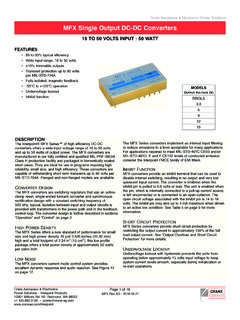

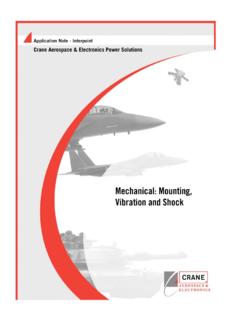
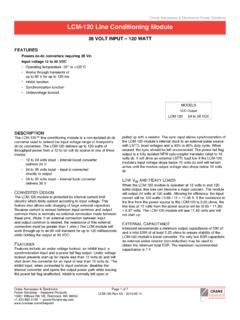

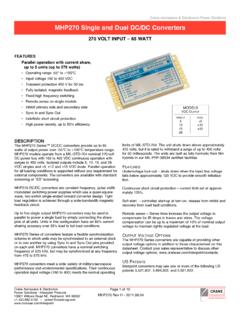




![Prof. S. Ben-Yaakov , DC-DC Converters [4- 1] …](/cache/preview/0/2/4/0/9/5/5/1/thumb-02409551fc5b66ad3d28f03a4747642a.jpg)
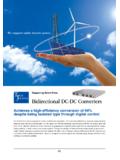

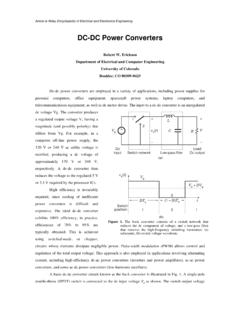
![Prof. S. Ben-Yaakov , DC-DC Converters [2- 1] …](/cache/preview/d/4/9/d/f/f/9/9/thumb-d49dff9902b8da452df79bf74a34b627.jpg)


